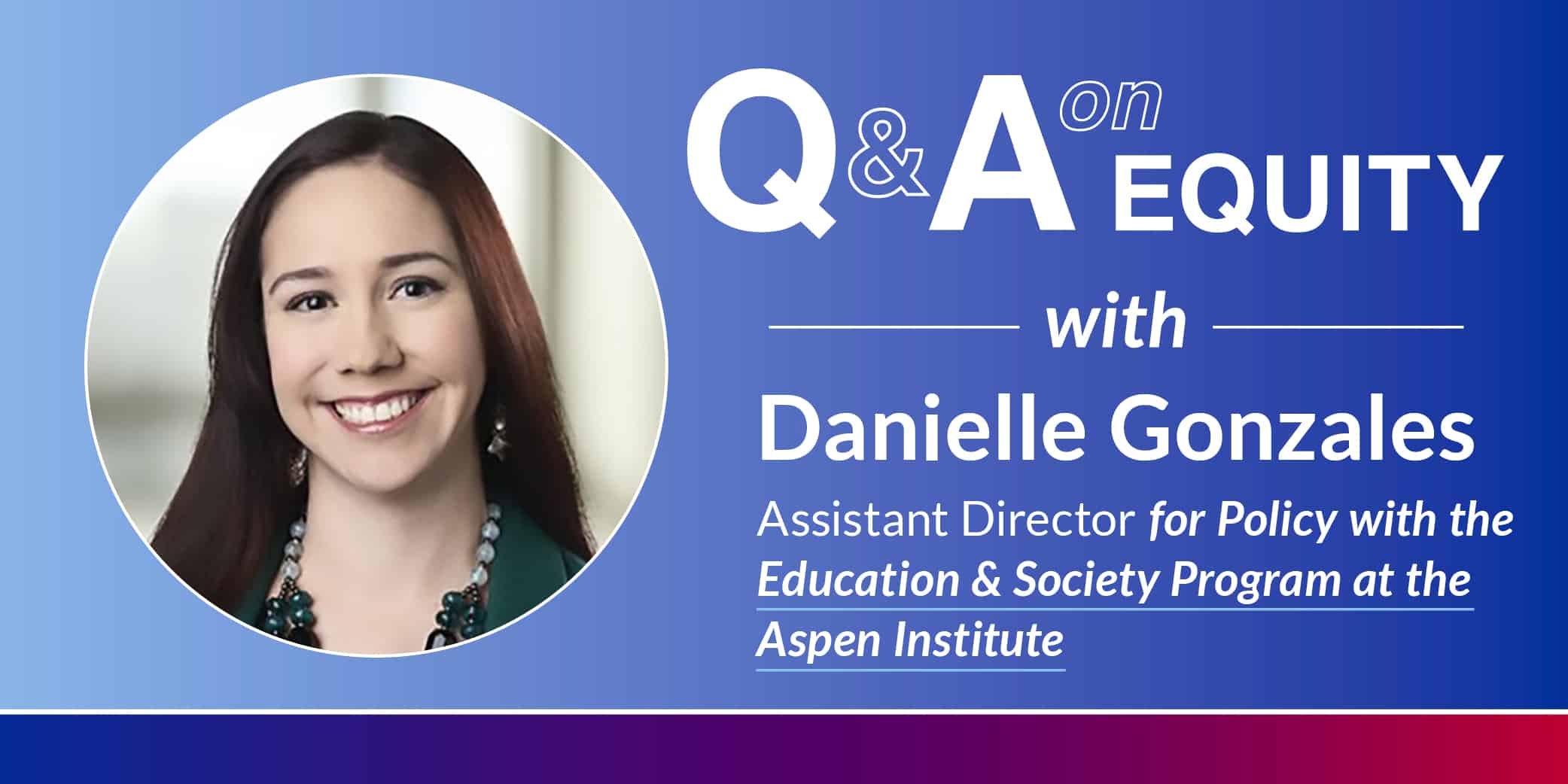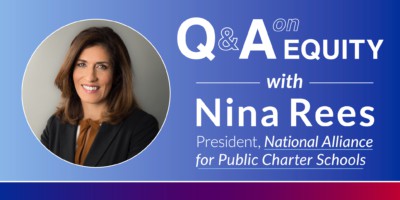
Q: How do you define equity in public education?
A: I grew up in New Mexico and left there to attend college on the east coast when I was 18. New Mexico is notoriously and unfortunately consistently ranked at or near the bottom of rankings of education and quality of life. It didn’t feel that way growing up though, I didn’t know I was missing out on anything. It wasn’t until I was in college that I realized that people had different education experiences. Sure, I had read of boarding schools and watched Saved by the Bell, but that was fiction, it didn’t occur to me that schools could really look like that. Slowly, I began to understand that my college peers had done and received opportunities I wasn’t even aware existed. They had taken prep courses for the SAT and ACT (and even taken the tests multiple times!), they had taken multiple Advanced Placement (AP) classes (and the associated exams!), they had family friends review their college application essays and leverage contacts to secure them internships, their parents and siblings had also graduated from high school and college. We had quite simply had different experiences because of where and how we grew up.
In an equitable education system, however, personal or social circumstances such as gender and gender identity, race/ethnicity, family background and income are not obstacles to accessing educational opportunities. There should be no obstacles. Kids growing up in New Mexico should have the same opportunities, rigor and access as kids growing up in New Hampshire, Massachusetts and even the fictional Bayside High.
Equity does not mean creating equal conditions for all students, but rather doing what is fair and driven by individual students’ needs. From a public policy perspective, this means providing differentiated supports to create the same conditions for low-income students and students of color that their more advantaged peers experience. Education leaders also must consider both inputs and outcomes when evaluating equity in education. On inputs, factors such as adequate funding, access to great teachers, rigorous coursework, enrichment and extracurricular opportunities (music, art, field trips, languages) all play a role in contributing to educational equity. On outcomes, achievement and attainment rates, graduation rates, suspension rates, and college enrollment or access to well-paying careers are all measures of equity.
Q: What policy mechanisms relating to ESSA would you identify as having the most potential to create a more equitable education system?
A: I’m really tempted to say that the new weighted student funding formula pilots for districts have the greatest potential to lead to a more equitable education system because it allows for 50 Local Education Agencies (LEAs) to design a school funding system that targets additional funds to groups of students with the greatest need; this is a direction more districts and states need to be heading toward. But I actually think that treating each funding stream, planning requirement, pilot or set-aside in ESSA as a discrete lever or issue to address is part of the problem. State and district leaders need to think holistically about their state strategic vision and then figure out how the various components of ESSA can help them achieve that vision.
My worry is that states work to respond to ESSA instead of making ESSA work for states. State leaders should choose one or two strategic equity priorities informed by their own data and goals and then use provisions in the law to focus attention and resources on these areas. If a state has significant numbers of English learners, significant growth of English learners, particularly stubborn achievement gaps, or a teacher shortage in a key area, then target resources to those areas. That said, a few of the strategic priorities states might want to consider are: increasing access to advanced coursework and high-quality instructional materials, broadening the definition of education to focus on the whole child and whole community, and improving low-performing schools. There are provisions across Title I, Title II, Title III, Title IV, and through public reporting, that can be pulled upon to meet the state’s vision and goals and create a more equitable education system. There are some significant new provisions, new requirements and new areas of flexibility within ESSA. Familiarity with the law will help states effectively leverage these mechanisms; to help state leaders get started, The Aspen Institute and Council of Chief State School Officers (CCSSO) released a paper Advancing Equity through ESSA: Strategies for State Leaders that includes the actual statutory language and citations to several (but not all) key levers that can advance state priorities across different priority areas.
Q: Based on your experience working with state leaders and policymakers, what has been the most common question or challenge states are grappling with as it relates to ESSA and equity?
A: The most common question we hear is “How do you define and measure equity?” Equity is complex, it’s about inputs, outcomes, agency and justice. It’s not the same as equality or fairness. Despite that complexity state leaders are looking for policy solutions and policies need to be measurable. How would you measure engagement and agency? How do you measure social capital? How do you lead for equity in the midst of a political environment in which many people have lost confidence in public and civic institutions? The reality is that many Americans have experienced the reality of inequity firsthand at the individual, institutional and structural level and don’t trust that government is the solution. On the other hand, there are significant segments of the population who don’t think we have a problem with educational equity at all. So state and national education leaders still have a lot of work to do to raise awareness of the scope of the problem. Many state leaders are unsure of where to start and shifts in federal role and responsibility with respect to equity and civil rights, as well as limited state funding make it difficult to wade in. To help state leaders get started, the Aspen Institute and CCSSO produced a list of over 60 possible state actions in Leading for Equity: Opportunities for State Education Chiefs. This report includes actions (policy, guidance, recommendations and more) across 10 different areas. Not every action will make sense in every state or context but there should be at least one thing that works for everyone.
The biggest challenge is getting real about the role of race and racism in education. In a nation that was founded on the genocide of one race and the enslavement of another, we need to talk about race. Even when other factors are accounted for, there are serious and persistent racial gaps that can only be addressed if it is a priority. State education leaders in particular need to approach every decision – every funding allocation, every policy – through a racial equity lens. Creating the space to discuss this is both difficult and essential. In most cases this will require expert facilitation and additional resources. Some organizations like Teaching Tolerance offer free resources that can help education leaders build cultural competency and self-awareness to understand their own biases and how those influence their words, actions and beliefs intentionally or not.
Q: What work does your organization have coming up (or recently completed) in this area?
A: The Aspen Education & Society Program is currently sponsoring the National Commission on Social, Emotional and Academic Development which is focusing on how to integrate social and emotional development more deeply with academics and other facets of K-12 education. Learning is social and emotional. Teachers and families know this, so our schools, systems and policies need to shift to be responsive to this reality. This focus on social and emotional development will hopefully bring new research on learning and brain development forward and highlight the value of the environment because part of achieving equity will be ensuring that all students feel emotionally and physically safe and welcome at school. The National Commission will be issuing a final report from the nation at the end of 2018 and I look forward to the recommendations and the discussion about what shifts we need to make to focus on these often overlooked elements of education.
Editor’s Note: This article was originally published as a blog post by the Hunt Institute and has been republished with permission.


